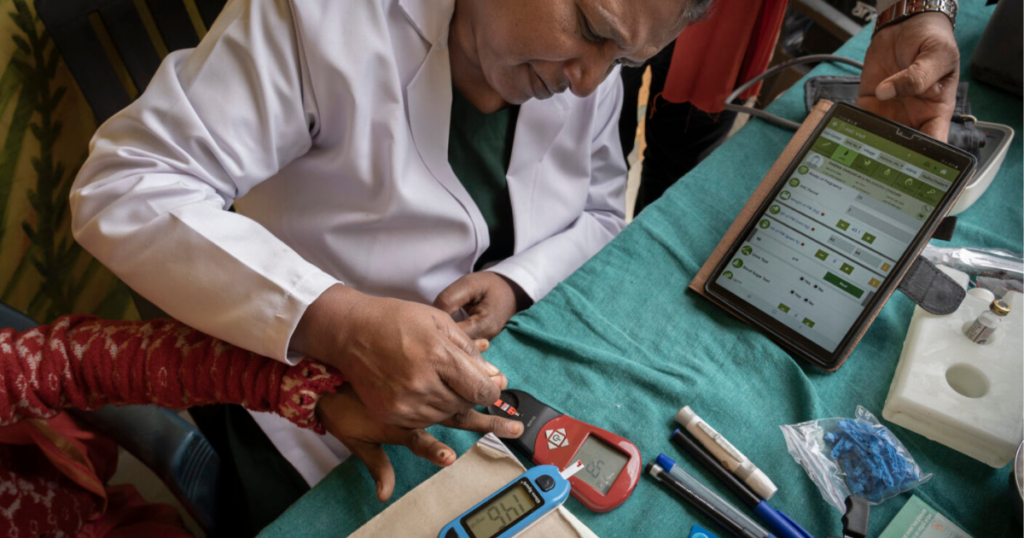The pandemic catalysed the adoption of digital health solutions among both providers and citizens and has shown great potential to bridge the gaps in the existing healthcare system. Globally, the digital health landscape is maturing rapidly, with investments in digital health reaching US $57.2 billion in 2021. India too is experiencing a rapid maturing of the digital health ecosystem. Launching the Ayushman Bharat Digital Mission (ABDM) is a step toward the long-pending digital standardisation of the healthcare sector.
Strong tailwinds, such as the changing patient and provider attitude toward digital solutions, burgeoning private sector investment, and an enabling environment created by government initiatives are helping India move towards a strong digital revolution. The benefits of which will enable greater accessibility and affordability of quality healthcare solutions for all. However, the existing gaps in digital infrastructure, as well as the disparities created due to socioeconomic factors such as a lack of digital literacy, affordability, gender biases, and age gaps among others, limit the reach and adoption of digital health solutions for a population that needs it the most.
There also is a fractured understanding within the ecosystem about what comprises digital health, how it is to be used, and what challenges and opportunities can stakeholders anticipate, especially to scale digital health adoption in underserved markets. Given the nascent space and latent understanding of digital health, its application in the underserved market requires addressing the following factors and challenges:
- As digital health starts to gain prominence, it is critical to ensure that there is a common vocabulary that is all-encompassing to effectively rally and align ecosystem stakeholders and ensure a collaborative approach towards key areas of need.
- Proactively identifying solutions based on target populations will ensure that, while we focus on the low-hanging fruits that can accelerate digital adoption among citizens and providers, we recognise that solutions are not uniform across populations.
- Given there are a number of approaches within the ecosystem towards the adoption of digital health, prioritisation on where to start is crucial. Among multiple factors, one must look at the target group, the specific challenge that is being solved, the existing consumer behaviour and the long-term sustainability of the solution.
- By bringing in diverse stakeholders who might traditionally be missed in conversations around digital health, and promoting innovative approaches to incentivise end-users, there is an opportunity to enable effective adoption of digital solutions for underserved populations.
A three-pronged approach to drive digital health adoption in the underserved market:
- Driving digital healthcare adoption at the provider and citizen level: There is untapped potential for digital health, which can improve the access to quality healthcare for the underserved population. To enable this, efforts are needed to improve the overall health-seeking behaviour among the citizens and ensure effective communication of the value proposition of digital health for both citizens and providers. System-wide incentives can be introduced to drive greater adoption of digital health. For example, innovating newer models that reduce the cost burden on both citizens and providers, distributing the financing burden to incentivise adoption, removing disincentives such as duplication of effort, and investing in building digital literacy for frontline workers and citizens.
- Reducing friction for solution providers to navigate system complexities: Advocacy efforts are needed for the creation and update of data privacy policies. For wider adoption of ABDM, the government can implement regulatory changes, offer meaningful incentives and impose penalties associated with non-compliance. Philanthropic organisations can support the solution developers in navigating the complex regulatory and procurement pathways, by providing legal and technical assistance. Philanthropic organisations can also provide initial risk capital to solution developers to encourage innovation and experimentation. Incubators in partnership with academic institutions, local civil society organisations (CSO), government or philanthropy can support the creation of a structured environment for solution developers to effectively test and validate their solutions on the ground.
- Creating an enabling environment that can address business model challenges: A thorough understanding of funding flows and cost-bearing stakeholders is necessary to enable different stakeholders to mitigate any additional financial burden on underserved populations. Mainstream capital providers and philanthropic funders could collaborate to identify innovative financial instruments, such as blended finance and outcome-based financing, to encourage start-ups to expand in the underserved ecosystem.
Author: Granthika Chatterjee
Technical review: Dr. Arun Jose from the Public Health Foundation of India (PHFI) and Lakshmi Sethuraman from Sattva




